Do you have a question about the Yamaha Clavinova CVP-805 and is the answer not in the manual?
Lists various chord types and their recognized patterns for fingered mode operation.
Modifies tonal characteristics by adjusting output frequency range.
Sound processor dividing frequency spectrum into bands for boosting or cutting.
Introduces Effect Blocks: System, Insertion, and Variation Effects.
Details on editing and saving System, Insertion, and Variation Effect settings.
Explains Chorus and Reverb as System Effects and how to edit their depth.
Adjusts the stereo position (Pan) and level (Volume) for each part.
Limits and compresses audio signal dynamics for the entire instrument.
Details on editing Master Compressor settings, types, and parameters.
Visual representation of the mixer signal flow for CVP-809 and CVP-805 models.
Sets parameters for playback of the current MIDI Song, including parts.
Adjusts display resolution, left/right notation, chord, lyrics, note names, and color.
Sets MIDI channels, key signature, and quantize for notation display.
Sets playback parameters for Audio Songs, like Vocal Cancel and repeat playback.
Instructions for viewing text files (.txt) from a USB flash drive.
Adjusts text file display, background picture, and font size/type.
Details on creating original Vocal Harmony types by editing preset parameters.
Guides importing Music Finder Records (.mfd) into the instrument's Playlist.
Explains how to search for Records within the Registration Memory.
Details on memorizing and saving recorded chord progression data as a bank file.
Guides recalling a Chord Looper Bank file and playing back a Style in loop.
Explains how to delete, save, recall, and edit Chord Looper Bank files.
Details on functions that can be assigned to pedals and footswitches.
Details on assigning functions to the ASSIGNABLE buttons.
Details common parameters for voice editing: Volume, Touch Sensitivity, Octave, Mono.
Explains the structure of Style data, composed of Sections and Channels.
Step-by-step guide for creating a new Style using the Style Creator.
Sets basic parameters like Section, Pattern Length, Tempo, and Beat.
Records Style data by playing the keyboard in real-time.
Records or edits notes one by one in the Style Edit display.
Copies channel data from existing Styles or Sections.
Edits already recorded channel data, adjusting parameters like Groove.
Sets Style File Format parameters for note conversion based on chords.
Sets the original key and chord type for the Source Pattern.
Determines note conversion based on chord type changes.
Explains the structure of MIDI Songs, consisting of 16 channels.
Step-by-step guide for creating a new MIDI Song using Step Recording.
Details on inputting melodies note by note using Step Recording controls.
Guides inputting chord and section change events one by one.
Explains how to edit recorded events like notes and voice selections.
Specifies the target for editing: channels, SysEx, lyrics, or chord/section events.
Converts chord/section events to actual sounded note data for songs.
Corrects or converts specific portions of Song data, like note timing.
Adjusts pitch-related parameters like Tuning, Octave, and Pitch Bend Range.
Sets parameters for VRM Piano category voices: VRM, Resonance, Reverb, Chorus.
Adjusts pitch and volume for each note individually on VRM Piano voices.
Links voices to default Voice Set parameters; can disable harmony feature.
Configures Voice category button behavior and S.Art2 Auto Articulation.
Guides selecting GM, XG, and MegaVoices from the 'Others' category.
Adjusts Dynamics Control, Display Tempo, and Stop ACMP for Style playback.
Defines characteristics of Pro, Session, Free Play, and Pianist Styles.
Configures the Guide function for keyboard practice and singing.
Assigns MIDI channels to the right-hand and left-hand parts.
Sets the language for displaying lyrics in songs.
Controls song playback modes like Repeat, Phrase Mark Repeat, and Quick Start.
Lets you play backing parts with MIDI Song playback using Performance Assistant.
Uses Punch In/Out to re-record specific sections of MIDI Songs.
Fine-tunes the pitch of the entire instrument in 0.2 Hz steps.
Selects or creates custom tunings (temperaments) for scales.
Lists and explains the ten pre-programmed MIDI templates available.
Sets MIDI System parameters like Clock, Transmit Clock, and Input.
Determines which MIDI channel is used for transmitting data from each part.
Determines which Part handles MIDI data received from external devices.
Sets the bass note for Style playback based on received MIDI note messages.
Determines chord type for Style playback based on MIDI note messages.
Initializes instrument settings to original factory defaults.
Saves and recalls instrument settings to/from User memory or USB flash drive.
Sets detailed parameters for connecting to a network in Access Point Mode.
| Voices | 1, 315 Voices + 49 Drum/SFX Kits + 480 XG Voices |
|---|---|
| Polyphony | 256 |
| Display | 9-inch color TFT LCD touch screen |
| Keyboard | 88-key Graded Hammer 3X (GH3) keyboard with synthetic ebony and ivory keytops |
| Speakers | 16 cm x 2 + 5 cm x 2 |
| Connectivity | USB to Host, USB to Device, MIDI IN/OUT, AUX IN, AUX OUT |
| Touch Sensitivity | Hard, Medium, Soft, Fixed |
| Pedals | Damper (with half-pedal support), Sostenuto, Soft |
| Featured Voices | Yamaha CFX, Bösendorfer Imperial |
| Effects | Reverb, Chorus, Master Compressor, Master EQ |
| Included Accessories | Owner's Manual, AC Power Cord, Bench |
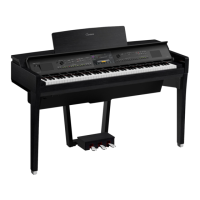

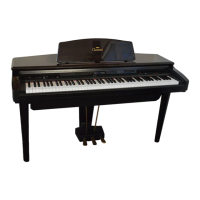
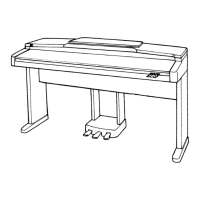




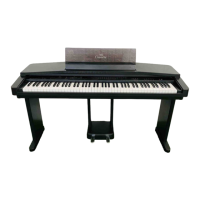
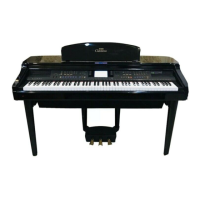
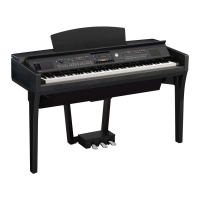
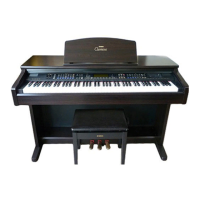
